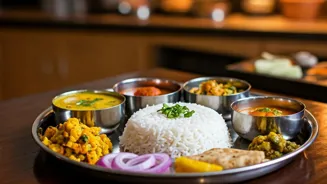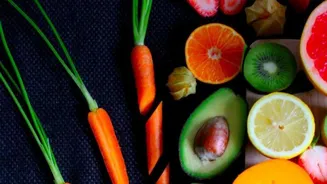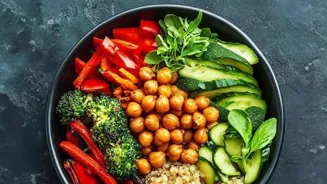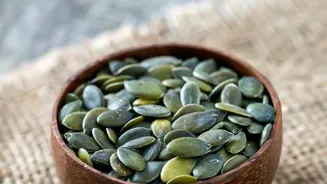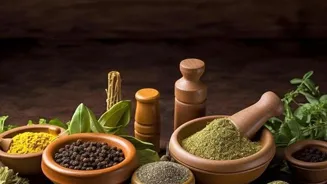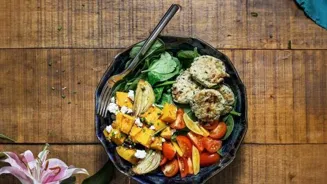Unlock the secrets of boosting your daily fiber intake for Indian diets! Dive in for a healthier you
In today’s fast-paced life, maintaining a healthy diet often takes a backseat. One crucial element that
frequently gets overlooked is fiber. Fiber, the indigestible part of plant-based foods, is vital for good digestion, weight management, and overall well-being.
For Indians, whose diets are often rich in refined carbohydrates, incorporating more fiber can make a significant difference. Here’s a simple guide to help you seamlessly integrate more fiber into your daily meals.
High-fiber breakfast sets tone for energized day
The first step is to start your day with a high-fiber breakfast. Instead of opting for white bread or processed cereals, choose whole grains like oats, ragi (finger millet), or poha (flattened rice) made with plenty of vegetables.
Adding fruits like bananas or berries will further enhance the fiber content. Remember, breakfast sets the tone for the day, and a fiber-rich start can help keep you feeling full and energized. Starting small and gradually increasing quantity is the way to go.
Modern diets lack essential nutrients; shift to healthier eating is crucial
Our diets have drastically changed over the years. Earlier, our diet used to compose of plenty of grains, vegetables and fruits. Unfortunately, we are hooked to quick bites and fast foods. This is where, ailments of different kinds start setting in. Its important to start right.
Include fruits and veggies in meals for health, variety, and fiber
Next, make fruits and vegetables the stars of your meals. Aim to include at least five servings of fruits and vegetables each day. Focus on consuming them whole rather than juiced, as juicing removes much of the fiber.
Good choices for Indians include apples, guavas, oranges, carrots, spinach, and okra (bhindi). Remember, variety is key, so try to include a range of colors and types to get a diverse mix of nutrients and fiber. Cooking methods matter too.
Avoid overcooking vegetables, as this can diminish their fiber content and nutrient value. Lightly steamed or stir-fried vegetables retain more of their goodness.
Switch to whole grains for more fiber; avoid refined grains
Switching to whole grains is another effective way to increase fiber intake. Replace refined grains like white rice and maida (refined flour) with whole grains like brown rice, whole wheat atta, and millets.
In Indian cuisine, consider incorporating dishes made with jowar (sorghum), bajra (pearl millet), and ragi. These grains are not only rich in fiber but also packed with other essential nutrients.
When buying bread and other baked goods, always check the label to ensure they are made with whole wheat or other whole grains. Be wary of products that are labeled "multi-grain" but still contain refined flour.
Incorporate lentils and legumes for fiber and protein in meals
Incorporate lentils and legumes into your diet regularly. Dals (lentil soups) are a staple in Indian cuisine and are an excellent source of fiber and protein. Include a variety of dals like toor dal, masoor dal, and moong dal in your meals.
Other legumes like chickpeas (chana), kidney beans (rajma), and black-eyed peas (lobia) are also fiber-rich and can be used in curries, salads, or as a side dish. Soaking legumes before cooking can improve their digestibility and reduce gas.
Sprouting legumes can further increase their nutritional value and fiber content.
Snack smart with nuts and seeds for health benefits
Snack smart with nuts and seeds. Instead of reaching for processed snacks, grab a handful of nuts like almonds, walnuts, or pistachios, or seeds like chia seeds, flax seeds, or sunflower seeds. Nuts and seeds are not only packed with fiber but also healthy fats and other nutrients.
Add them to your breakfast cereal, yogurt, or salads, or simply enjoy them as a mid-day snack. Remember to consume nuts and seeds in moderation, as they are also high in calories. Chia seeds and flax seeds can be easily added to smoothies, juices, or even sprinkled on top of your meals.
Eat fruits and veggies with peels for more fiber
Don't peel your fruits and vegetables unnecessarily. Many fruits and vegetables have a significant amount of fiber in their peels. For example, apples, pears, and potatoes all have a higher fiber content when eaten with their skins.
Of course, be sure to wash your produce thoroughly before eating to remove any dirt or pesticides. When possible, choose organic produce to minimize your exposure to harmful chemicals. Consider adding potato skins to your homemade fries or roasting them as a snack.
Enhance meals with fiber-rich toppings for added nutrition
Add fiber-rich toppings to your dishes. Sprinkle flax seeds, chia seeds, or chopped nuts on your salads, yogurt, or oatmeal. Add a spoonful of wheat bran to your smoothies or sprinkle it on your cereal. These small additions can significantly boost the fiber content of your meals.
Experiment with different toppings to find your favorites and make your meals more interesting. Consider toasted sesame seeds or sunflower seeds as flavorful and fiber-rich options.
Choose high-fiber, low-sugar foods; compare labels
Read food labels carefully. When shopping for packaged foods, pay attention to the fiber content listed on the nutrition facts label. Choose products that are high in fiber and low in added sugars and unhealthy fats. Be aware of serving sizes and adjust your intake accordingly.
Look for products that contain at least 3-5 grams of fiber per serving. Compare different brands to find the most fiber-rich options.
Use whole wheat flour for baking, boost fiber content with swaps and additions
Use whole wheat flour for baking. When baking at home, replace refined flour (maida) with whole wheat flour. This simple swap can significantly increase the fiber content of your baked goods. You can also experiment with other whole grain flours like ragi flour, jowar flour, or bajra flour.
Start by substituting a portion of the refined flour with whole wheat flour and gradually increase the amount as you get used to the taste and texture. Consider adding flax seeds or wheat bran to your baked goods for an extra fiber boost.
Stay hydrated for optimal fiber absorption and digestion
Stay hydrated. Fiber works best when it absorbs water, so it's important to drink plenty of fluids throughout the day. Aim for at least 8-10 glasses of water per day. This will help prevent constipation and ensure that the fiber you're consuming can do its job effectively.
Other fluids like herbal teas, coconut water, and buttermilk can also contribute to your daily fluid intake. Avoid sugary drinks like soda and juice, as they can negate the benefits of a fiber-rich diet.
Increase fiber intake gradually to avoid discomfort
Increase fiber gradually. If you're not used to eating a lot of fiber, it's important to increase your intake gradually. Adding too much fiber too quickly can cause bloating, gas, and discomfort.
Start by adding one or two high-fiber foods to your diet each day and gradually increase the amount as your body adjusts. Pay attention to how your body reacts and adjust your intake accordingly. If you experience any discomfort, reduce your fiber intake and try again later.
Increase fiber intake for better health with easy tips
By following these simple tips, you can easily increase your daily fiber intake and enjoy the many health benefits that fiber has to offer. Remember, a fiber-rich diet is essential for good digestion, weight management, and overall well-being.
Make small changes to your eating habits over time, and you'll be well on your way to a healthier you.
AI Generated Content. Glance/InMobi shall have no liability for the content

